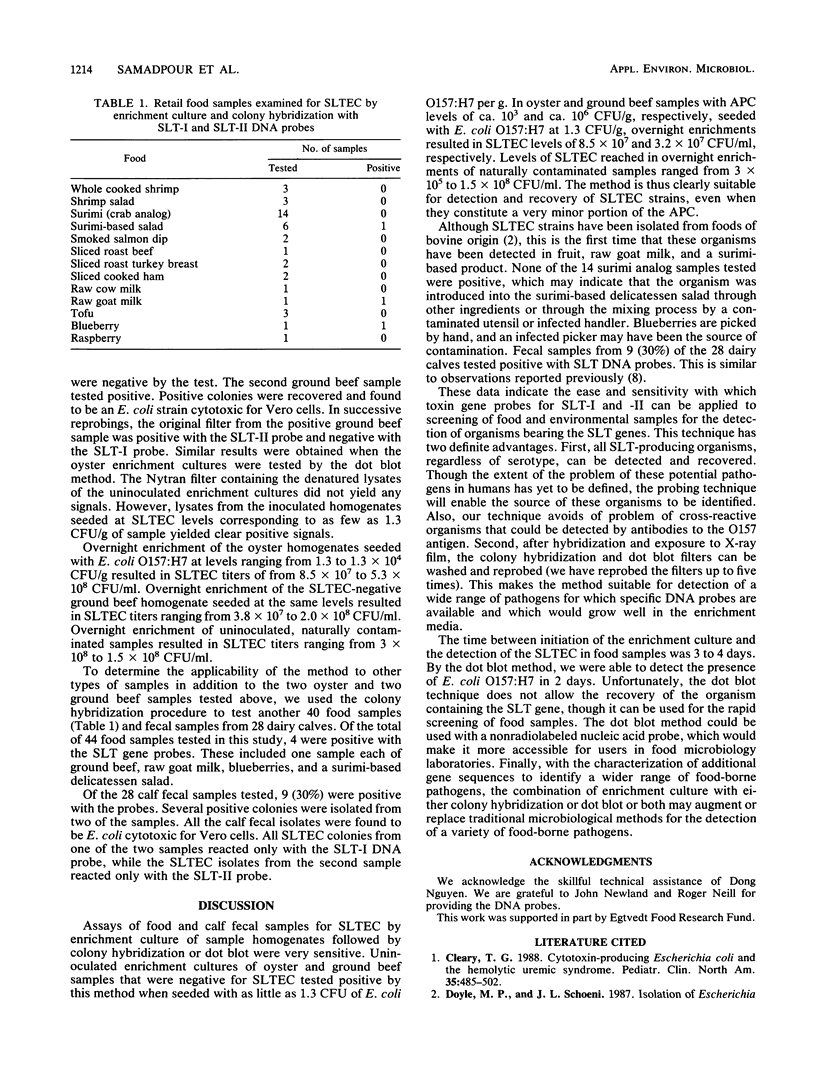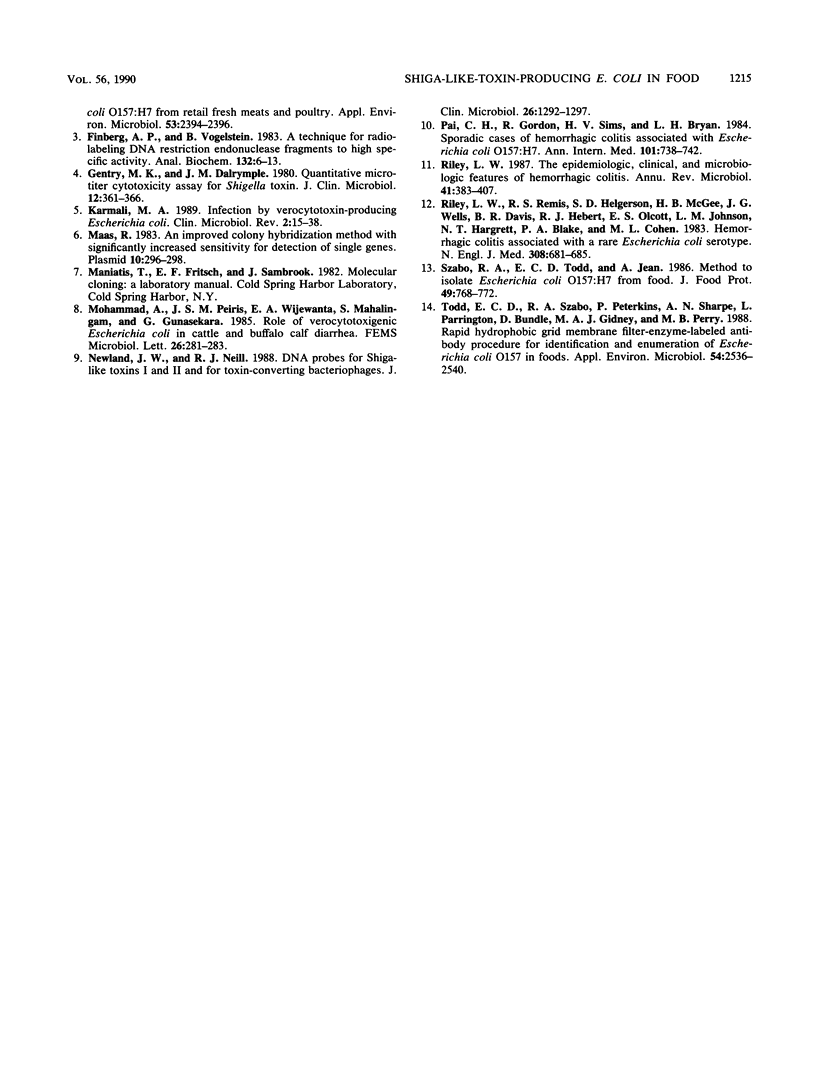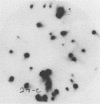Abstract
The use of DNA probes for Shiga-like toxin I (SLT-I) and SLT-II for detection of SLT-producing Escherichia coli (SLTEC) in foods and calf fecal samples was evaluated. Enrichment cultures were prepared from food or fecal samples. Colonies formed by plating of enrichment cultures were probed for SLTEC by colony hybridization. Alternatively, enrichment cultures were analyzed for SLTEC presence by dot blot. The lowest detected concentration of SLTEC in sample homogenates inoculated with E. coli O157:H7 corresponded to 1.3 CFU/g of sample. Of the 44 food samples and 28 fecal samples from dairy calves tested by the colony hybridization method, 4 food samples, including ground beef, raw goat milk, blueberries, and surimi-based delicatessen salad, and 9 calf fecal samples were positive with the SLT probes. The dot blot technique yielded results within 48 h and can be used as a fast and sensitive method of detection for SLTEC in foods and calf fecal samples. The colony hybridization technique took 3 to 4 days but permits recovery of the positive colonies when desired.
Full text
PDF



Images in this article
Selected References
These references are in PubMed. This may not be the complete list of references from this article.
- Cleary T. G. Cytotoxin-producing Escherichia coli and the hemolytic uremic syndrome. Pediatr Clin North Am. 1988 Jun;35(3):485–501. doi: 10.1016/s0031-3955(16)36467-7. [DOI] [PubMed] [Google Scholar]
- Doyle M. P., Schoeni J. L. Isolation of Escherichia coli O157:H7 from retail fresh meats and poultry. Appl Environ Microbiol. 1987 Oct;53(10):2394–2396. doi: 10.1128/aem.53.10.2394-2396.1987. [DOI] [PMC free article] [PubMed] [Google Scholar]
- Feinberg A. P., Vogelstein B. A technique for radiolabeling DNA restriction endonuclease fragments to high specific activity. Anal Biochem. 1983 Jul 1;132(1):6–13. doi: 10.1016/0003-2697(83)90418-9. [DOI] [PubMed] [Google Scholar]
- Gentry M. K., Dalrymple J. M. Quantitative microtiter cytotoxicity assay for Shigella toxin. J Clin Microbiol. 1980 Sep;12(3):361–366. doi: 10.1128/jcm.12.3.361-366.1980. [DOI] [PMC free article] [PubMed] [Google Scholar]
- Karmali M. A. Infection by verocytotoxin-producing Escherichia coli. Clin Microbiol Rev. 1989 Jan;2(1):15–38. doi: 10.1128/cmr.2.1.15. [DOI] [PMC free article] [PubMed] [Google Scholar]
- Maas R. An improved colony hybridization method with significantly increased sensitivity for detection of single genes. Plasmid. 1983 Nov;10(3):296–298. doi: 10.1016/0147-619x(83)90045-8. [DOI] [PubMed] [Google Scholar]
- Newland J. W., Neill R. J. DNA probes for Shiga-like toxins I and II and for toxin-converting bacteriophages. J Clin Microbiol. 1988 Jul;26(7):1292–1297. doi: 10.1128/jcm.26.7.1292-1297.1988. [DOI] [PMC free article] [PubMed] [Google Scholar]
- Pai C. H., Gordon R., Sims H. V., Bryan L. E. Sporadic cases of hemorrhagic colitis associated with Escherichia coli O157:H7. Clinical, epidemiologic, and bacteriologic features. Ann Intern Med. 1984 Dec;101(6):738–742. doi: 10.7326/0003-4819-101-6-738. [DOI] [PubMed] [Google Scholar]
- Riley L. W., Remis R. S., Helgerson S. D., McGee H. B., Wells J. G., Davis B. R., Hebert R. J., Olcott E. S., Johnson L. M., Hargrett N. T. Hemorrhagic colitis associated with a rare Escherichia coli serotype. N Engl J Med. 1983 Mar 24;308(12):681–685. doi: 10.1056/NEJM198303243081203. [DOI] [PubMed] [Google Scholar]
- Riley L. W. The epidemiologic, clinical, and microbiologic features of hemorrhagic colitis. Annu Rev Microbiol. 1987;41:383–407. doi: 10.1146/annurev.mi.41.100187.002123. [DOI] [PubMed] [Google Scholar]
- Todd E. C., Szabo R. A., Peterkin P., Sharpe A. N., Parrington L., Bundle D., Gidney M. A., Perry M. B. Rapid hydrophobic grid membrane filter-enzyme-labeled antibody procedure for identification and enumeration of Escherichia coli O157 in foods. Appl Environ Microbiol. 1988 Oct;54(10):2536–2540. doi: 10.1128/aem.54.10.2536-2540.1988. [DOI] [PMC free article] [PubMed] [Google Scholar]



